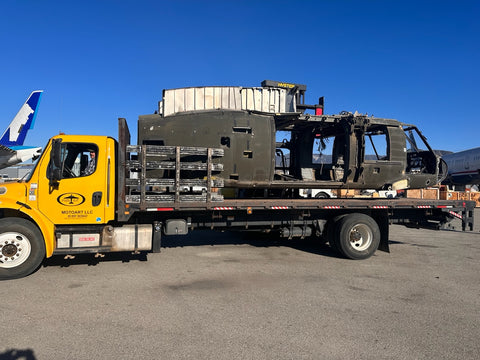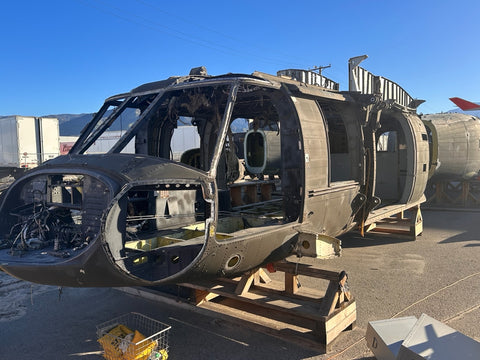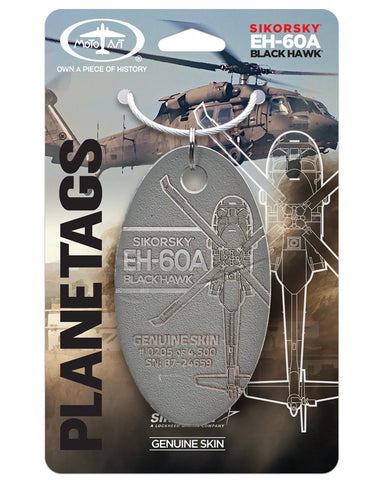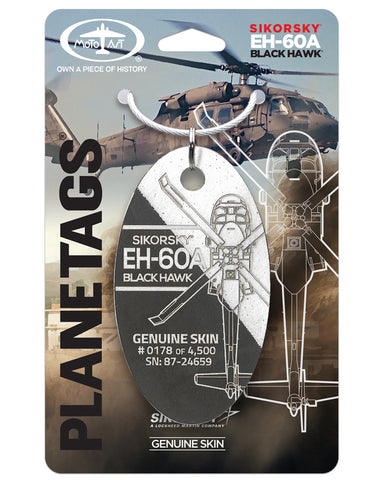
- by Dianna Lopez
Sikorsky UH-60 Black Hawk: A Multi-Role Helicopter
- by Dianna Lopez
A question? Visit our contact page
This site uses cookies for better user experience and analytics.

The latest entrant into MotoArt’s encyclopedia of aircraft is a helicopter. The Sikorsky UH-60 has become one of the most widely used helicopters in the world, serving in a variety of roles, including troop transport, medical evacuation, and search and rescue. Read more about one EH-60A, 87-24659, its development, history and how MotoArt owner Dave Hall found it, then get one for your own PlaneTags collection.

UH-60A Blackhawk - RIAT 2015 flickr photo by Airwolfhound shared under a Creative Commons (BY-SA) license
The Sikorsky UH-60A Black Hawk is a medium-lift utility helicopter that was developed by the United States Army in the late 1970s as a replacement for the aging UH-1 Huey helicopter. It was designed to transport troops, weapons, and supplies in both day and night operations, as well as perform medical evacuation, search and rescue, and other missions.
The UH-60A was first introduced into service with the U.S. Army in 1979, and quickly became a mainstay of its helicopter fleet. It was designed with advanced technologies for the time, including a four-bladed main rotor system that provided greater lift capability and reduced noise levels, and a sophisticated avionics suite that included digital displays, autopilot, and advanced navigation systems. It was powered by two General Electric T700-GE-700 turboshaft engines, which provided a top speed of 222 mph (357 km/h) and a range of 368 miles (592 km).
Over the years, several variants of the UH-60A were developed, including the MH-60L and MH-60M, which were optimized for special operations missions, and the HH-60G Pave Hawk, which was used for combat search and rescue. The UH-60A was also modified for civilian use as the S-70 Black Hawk, which is used for firefighting, law enforcement, and other missions.
The Black Hawk has been used extensively in military operations around the world, including during the Gulf War, the Iraq War, and the War in Afghanistan. It has also been used in humanitarian missions, including disaster relief efforts following Hurricane Katrina in the United States and the 2010 earthquake in Haiti. The Black Hawk was also adopted by many other countries, including Australia, Japan, South Korea, and Saudi Arabia, among others. The 5,000 Black Hawk was delivered January 20, 2023, with Sikorsky, a Lockheed Martin company, prepared to support Black Hawks for the foreseeable future.
“We are committed to all H-60 and S-70 operators and look forward to enduring partnerships on the Hawk program in the years to come. It remains our priority to fulfill our customers’ requirements and meet the needs of current and future operational units. With unmatched versatility and global interoperability, Hawk aircraft continue to advance 21st century security.” - Nathalie Previte, vice president of Army and Air Force Systems at Sikorsky

U.S. Soldiers assigned to the 2nd Squadron, 2nd Cavalry Regiment conduct air movement training in preparation for their upcoming deployment at the Joint Multinational Training Command's Grafenwoehr Training Area, Bavaria, Germany, Aug. 13, 2013. (DoD photo by Gertrud Zach, U.S. Army/Released) - Public Domain By U.S. Department of Defense Current Photos - Link
The development of the UH-60A Black Hawk began in the early 1970s, when the U.S. Army began to search for a replacement for its aging fleet of UH-1 Huey helicopters. The Army issued a request for proposals (RFP) for a new utility helicopter that could carry more troops and equipment, had a greater range and speed, and was more reliable and easier to maintain than the Huey. Several helicopter manufacturers submitted proposals, including Sikorsky and rival Boeing-Vertol with the YUH-61A. Sikorsky’s UH-60 was eventually selected as the winner of the competition. Development of a prototype of the UH-60A began in 1972, and the first flight of the YUH-60A prototype took place in 1974.
The UH-60A was designed to meet the Army's requirements for a medium-lift utility helicopter that could operate in a variety of environments and conditions. One of its key features was its ability to operate at night and in adverse weather conditions, thanks to its advanced navigation and targeting systems, which included an infrared detection system and a laser rangefinder. The helicopter was also designed to be easily maintainable and repairable in the field, with a modular construction that allowed for quick replacement of damaged parts.
After several rounds of testing and evaluation, the UH-60A was formally adopted by the U.S. Army in 1979, and production took place from 1977 to 1989. Over the years, several variants of the Black Hawk have been developed, including the MH-60L and MH-60M for special operations, the Air Force HH-60G Pave Hawk for combat search and rescue, and the S-70 for civilian use.
During the period 87-24659 served with the U.S. Army, the UH-60 Black Hawk demonstrated its versatility and usefulness in both military and humanitarian operations around the world. The Black Hawk was widely used for various missions by the United States military and other countries around the world.
Sikorsky is an American aircraft manufacturer, founded in 1925 by Igor Sikorsky and now a subsidiary of Lockheed Martin Corporation. They are well known for producing some of the most advanced and innovative helicopters in the world, as well as early pioneering aircraft designs. Its helicopter line includes both military and civilian helicopters, ranging from light utility helicopters to heavy-lift transport helicopters.
Arguably one of the most famous helicopters produced by Sikorsky is the UH-60 Black Hawk. They have also produced several other helicopters, including:
For civilian use, Sikorsky produces the S-76 and S-92 helicopters, which are used for offshore oil rig transport, executive transport, and search and rescue missions. The company has also developed several experimental helicopters, such as the X2 and the S-97 Raider, which use advanced technology to achieve high speeds and maneuverability.

Sikorsky Helicopters 1945 flickr photo by Tom McKinnon shared under a Creative Commons (BY-SA) license
Sikorsky has a long history of innovation and has been at the forefront of helicopter design and development for nearly a century. Its helicopters are known for their reliability, durability, and versatility, and have played a critical role in military and civilian operations around the world.
This Sikorsky UH-60 was constructed as an EH-60A in 1987. It was delivered to the U.S. Army that year as s/n 87-24659. While this aircraft’s history is unavailable or remains classified, some who have worked with this aircraft have noted that it served with the 3rd Infantry Division at Hunter Army Airfield GA during the 1990s. By August 2018 it had already retired from military service and was sold to Unical Aviation Inc, with a new registration N160KA. It was disassembled in 2020.
The EH-60, a variant of the Sikorsky UH-60 helicopter, is an airborne electronic warfare aircraft that was developed by the U.S. Army. It was specifically designed to provide electronic warfare support for ground troops during combat operations. It was equipped with advanced electronic warfare systems, including signal detection and jamming equipment, to locate and disrupt enemy communications and radar systems. It was also equipped with a sophisticated intelligence gathering system, which allowed it to intercept and analyze enemy communications.
The EH-60 was used extensively during the Gulf War in 1991 and in Somalia during Operation Restore Hope in the early 1990s. The EH-60 program was eventually canceled in the mid-1990s due to budget constraints and changing military priorities. Some of the EH-60s were converted into other roles, such as medical evacuation helicopters, while others were retired from service.


Dave Hall and the MotoArt team couldn't believe it when they found out material from 87-24659 was available. "The Black Hawk is such an iconic helicopter," says Hall. "And to be able to tag a EH-60, which was used in electronic warfare and one of about 60 built, is so meaningful."
These photos are from the team's collection.







The Sikorsky EH-60 Black Hawk PlaneTags are numbered in a series of 4,500 and will be released April 4, 2023 on planetags.com. Make sure you get the Black Hawk you want. Sign up for our mailing list so you don’t miss notifications for new releases, including this one. Certain colors will sell out quickly.






MotoArt has introduced several helicopter PlaneTags over the years. The UH-60A will be joining a tough group of helis in the collection. Grab an UH-60 and these helicopter PlaneTags before they disappear like the Bell Huey UH-1F PlaneTags from 66-1222 (sold out).
From Warbird to Water Bomber: The Epic Life of the Hawaii Mars
In the world of aviation, few aircraft have lived a life as large, or as long, as the Hawaii Mars. Towering over most of its contemporaries with a wingspan of 200 feet, this mighty flying boat was born in the final days of World War II, then quietly transformed into one of the most iconic aerial firefighting aircraft the world has ever seen. From military transport to firefighting titan, the Hawaii Mars represents one of aviation’s most extraordinary second acts.
In 2025, MotoArt obtained an original wing of this aircraft and created special PlaneTags, made exclusively for the Martin family members and Mars workers. On December 11, 2025, Hawaii Mars PlaneTags will be available to the general public for the first time.
F-14 Tomcat Coasters: A Legendary Fighter Reimagined for Your Home
Few aircraft define an era quite like the Grumman F-14 Tomcat. Sleek, powerful, and unmistakably iconic, the Tomcat was the Navy’s premier fleet defense fighter for more than three decades. From Cold War missions to pop culture stardom, the F-14 remains one of the most recognizable and beloved aircraft ever built. Today, MotoArt is proud to introduce the F-14 Tomcat Coaster Set, created from authentic F-14 aircraft material.
PR-AJB: The Story of an Azul Airbus A320 With a Global Journey
Every airplane has a story, and some travel farther than others before their flying days are over. PR-AJB was one of those well-traveled aircraft. This Airbus A320 started its life flying British families on long-awaited holidays, then later crossed the Atlantic to join the growing fleet of Azul Linhas Aéreas Brasileiras. Over nearly nineteen years it picked up new registrations, new paint, new routes and a new home, carrying thousands of passengers along the way.
Its journey reflects how widely the A320 family has spread around the world and how easily these aircraft adapt to whatever their next chapter requires. PR-AJB also arrived at Azul during an important period of expansion as the airline worked to connect more cities across Brazil. In this blog we will explore where the aircraft came from, what it did during its short time with Azul, and how it eventually came to rest in Florida. We will also share how MotoArt recovered material from the retired airframe and created PlaneTags so its story can continue in a new way.


Share:
Aloha Airlines 737-200: Pioneering Low-Cost Air Travel in Hawaii
Boeing 757: Celebrating US Airways Heritage